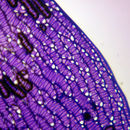Comments
provided by eFloras
This is a common species in northeastern and southwestern China. It is characterized by having rather robust and jade green plants that frequently produce sporophytes and by having large and squarrose branch leaves.
- license
- cc-by-nc-sa-3.0
- copyright
- Missouri Botanical Garden, 4344 Shaw Boulevard, St. Louis, MO, 63110 USA
Comments
provided by eFloras
In its typical robust form with strongly squarrose branch leaves, Sphagnum squarrosum is unmistakeable. Smaller forms such as occur in the higher mountains may be difficult to identify accurately without careful examination of microscopic details. In the tundra there sometimes occur large, terete forms of S. squarrosum but these are usually considerably more robust than S. teres. See also discussion under 14. S. strictum.
- license
- cc-by-nc-sa-3.0
- copyright
- Missouri Botanical Garden, 4344 Shaw Boulevard, St. Louis, MO, 63110 USA
Description
provided by eFloras
Plants rather robust, jade green to yellowish green or yellowish brown, in loose tufts. Stem cortex in 2–4 layers, hyaline cells thin-walled, without fibrils, sometimes with large pores; central cylinder pale green or yellowish orange. Stem leaves 1.6–1.7 mm × 1.0–1.4 mm, large, ligulate, rounded obtuse, somewhat lacerate at the apex; borders narrow, indistinct; hyaline cells in the upper half broadly rhomboidal, often undivided, without fibrils and pores, sometimes divided, cells in the lower half narrowly rhomboidal, sometimes with the traces of fibrils, with large pores. Branches in fascicles of 4–5, with 2–3 spreading, stout. Branch leaves 2.0–2.3 mm × 1.0–1.2 mm, broadly ovate-lanceolate, concave, strongly squarrose and gradually narrowed to an involute-concave acumen from an erect base; margins involute, blunt and dentate at the apex; hyaline cells densely fibrillose, with small, ringed pores in the upper cells, half-elliptic pores at the opposite ends in the lower cells on the ventral surface, with a few pores at the upper corners in the upper cells, more and more pores at the opposite ends in the lower half on the dorsal surface; inner walls adjacent to green cells sometimes faintly papillose; green cells in cross section triangular to trapezoidal, exposed more broadly on the dorsal surface, also slightly exposed on the ventral surface. Dioicous; antheridial branches green; archegonial branches elongate. Perigonial leaves smaller than vegetative branch leaves. Perichaetia leaves large, broadly ligulate, concave. Spores yellowish, papillose, 22–25 µm in diameter.
- license
- cc-by-nc-sa-3.0
- copyright
- Missouri Botanical Garden, 4344 Shaw Boulevard, St. Louis, MO, 63110 USA
Description
provided by eFloras
Plants robust, stiff; green, pale green, yellow-green; large terminal bud; typically as loose carpets in coniferous forests. Stem green to red-brown; 2-3 superficial cortical layers. Stem leaves shorter than branch leaves, ovate-lingulate to oblong-lingulate, 1.6-1.8 × 1-1.2 mm; hyaline cells mostly nonseptate. Branches long and tapering with distinct squarrose spreading leaves, often terete in tundra forms. Branch fascicles with 2 spreading and 2-3 pendent branches. Branch stems with 1-2 layers of cortical cells. Branch leaves larger than stem leaves, 1.9-2.8 mm, conspicuously squarrose from ovate-hastate base and abruptly narrowed 1/2-1/3 distance from apex into involute-concave acumen, often terete in tundra forms; hyaline cells convex on both surfaces, non-ringed pores at ends and corners of cells, ringed pores on concave surface (4-8/cell) and nonringed pores (2-4/cell) on convex surface, internal commissural walls smooth or indistinctly papillose, chlorophyllous cells ovate triangular with widest part at or close to the convex surface. Sexual condition monoicous. Spores 17-30 µm; proximal surface finely papillose, distal surface smooth with raised bifurcated Y-mark sculpture; proximal laesura more than 0.5 spore radius.
- license
- cc-by-nc-sa-3.0
- copyright
- Missouri Botanical Garden, 4344 Shaw Boulevard, St. Louis, MO, 63110 USA
Distribution
provided by eFloras
Distribution: China, India, Korea, Japan, Central Asia, Europe, Greenland, North America, New Zealand, and North Africa.
- license
- cc-by-nc-sa-3.0
- copyright
- Missouri Botanical Garden, 4344 Shaw Boulevard, St. Louis, MO, 63110 USA
Habitat
provided by eFloras
Habitat: in seasonally flooded areas or on wet soil under conifers; sometimes on rotten wood in shade.
- license
- cc-by-nc-sa-3.0
- copyright
- Missouri Botanical Garden, 4344 Shaw Boulevard, St. Louis, MO, 63110 USA
Synonym
provided by eFloras
Sphagnum cymbifolium var. squarrosum (Crome) Nees & Hornsch., Bryol. Germ. 1: 11. 1823. Sphagnum teres var. squarrosum (Crome) Warnst., Eur. Torfm. 121. 1881, nom. illeg.
Sphagnum squarrosum var. subsquarrosum Russ. ex Warnst., Hedwigia 27: 271. 1888.
- license
- cc-by-nc-sa-3.0
- copyright
- Missouri Botanical Garden, 4344 Shaw Boulevard, St. Louis, MO, 63110 USA
Synonym
provided by eFloras
Sphagnum squarrosum var. imbricatum Schimper
- license
- cc-by-nc-sa-3.0
- copyright
- Missouri Botanical Garden, 4344 Shaw Boulevard, St. Louis, MO, 63110 USA

